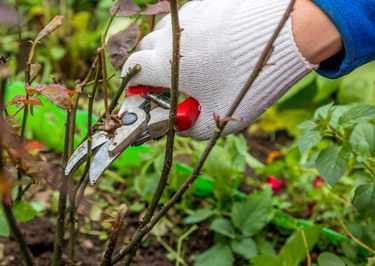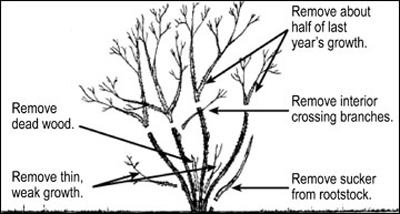Pruning Roses
Contact
University of Arkansas System
Division of Agriculture
Cralley Warren Building
Room 16
2601 N. Young Ave.
Fayetteville, AR 72704
Pruning Roses
By Sherrie Smith
February 20, 2023
Plant Health Clinic Disease Note: Issue 1
 February is the time to prune roses. However, timing is variable depending on weather.
You want to prune before the rose starts new growth.
February is the time to prune roses. However, timing is variable depending on weather.
You want to prune before the rose starts new growth.
Basic rose pruning involves removing dead, damaged, or diseased branches. Improperly pruned roses have more dieback than those which are pruned properly. Dieback occurs when a pruning cut has been made in the middle of a branch as opposed to at the bud eye. Because the rose directs growth into the terminal bud, any portion of the branch left between the pruning cut and next bud will die back. Dead wood is usually brown or even black in color.
How much should I prune?
How much to prune live canes depends on both what type of rose you are pruning and how large a plant you want. For example, Hybrid Teas will have fewer blooms when pruned short, but the blooms will be larger. People who show Hybrid Teas Roses prune this way. However tall you want a Hybrid Tea, all canes smaller than a pencil should be removed from the base of the rose. All canes crossing each other through the middle should be removed. Always prune right above an outward facing eye.
For Shrub Roses such as Knockout Roses, we recommend removing at least 1/3 of the height as we know the mite that vectors Rose Rosette Disease overwinters in the top third of the plant.
Climbing Roses that rebloom need any dead or damaged canes removed.
If it is a Once Blooming Rose, do not prune before bloom in the spring or you will prune out all the coming season’s blooms. Prune Once Bloomers immediately after they finish blooming.

Illustration by Missouri Extension
Take aways:
- Prune before new growth starts in the spring except for once blooming roses.
- Remove any canes smaller in diameter than a pencil.
- Always prune above an outward facing eye.
Follow us on Facebook for more timely tips!
This work is supported by the Crop Protection and Pest Management Program [grant no. 2017-70006- 27279/project accession no. 1013890] from the USDA National Institute of Food and Agriculture.